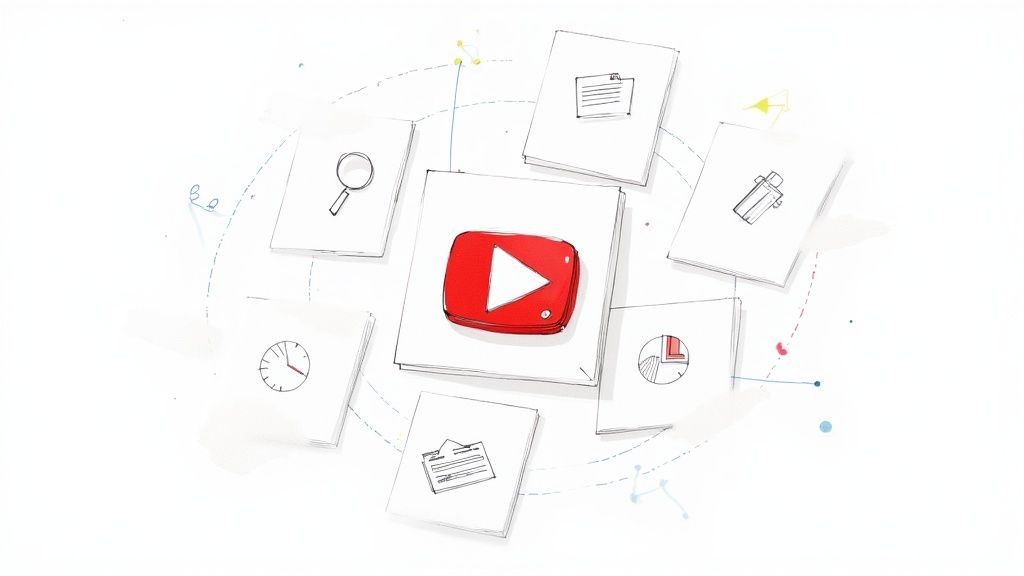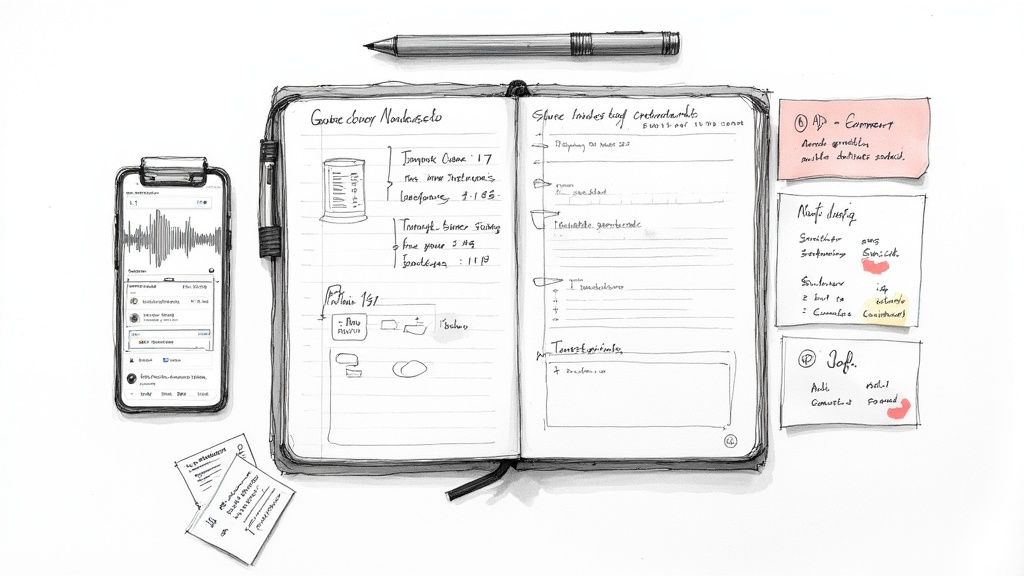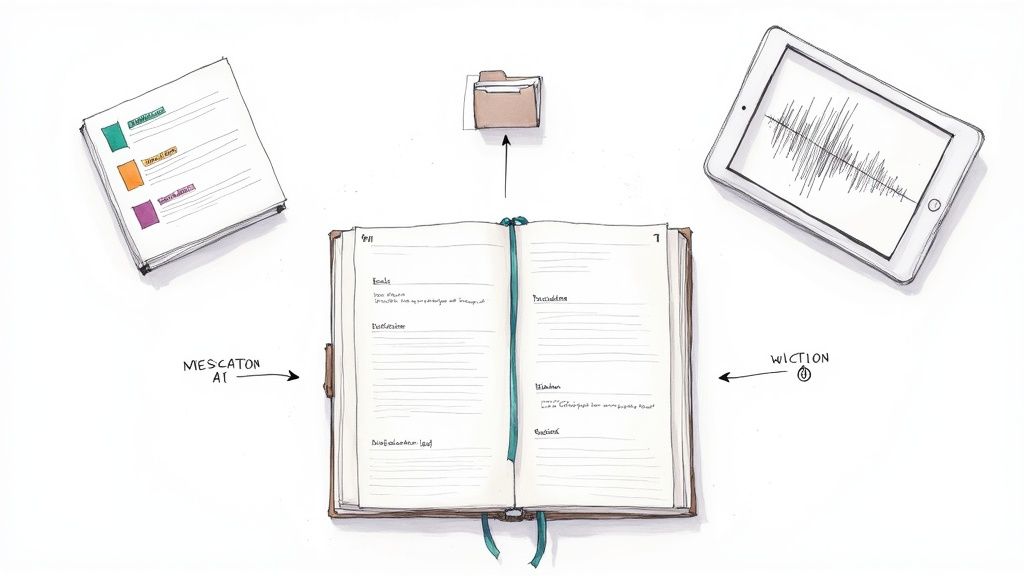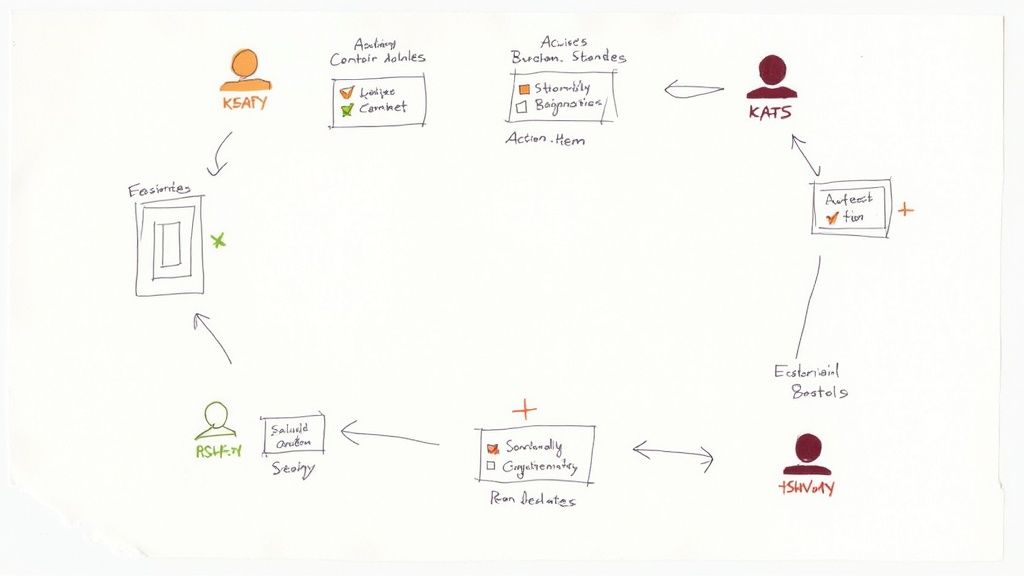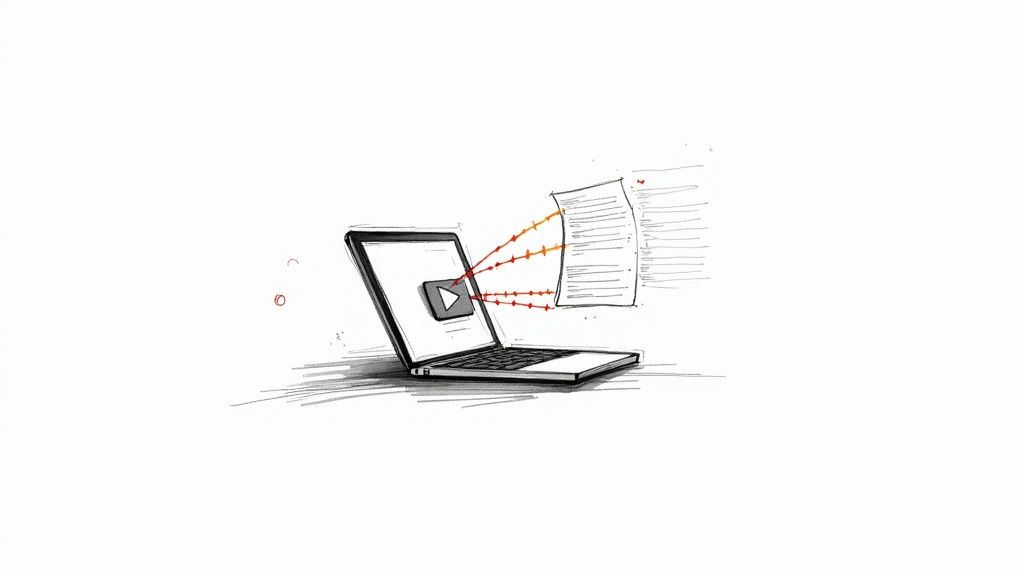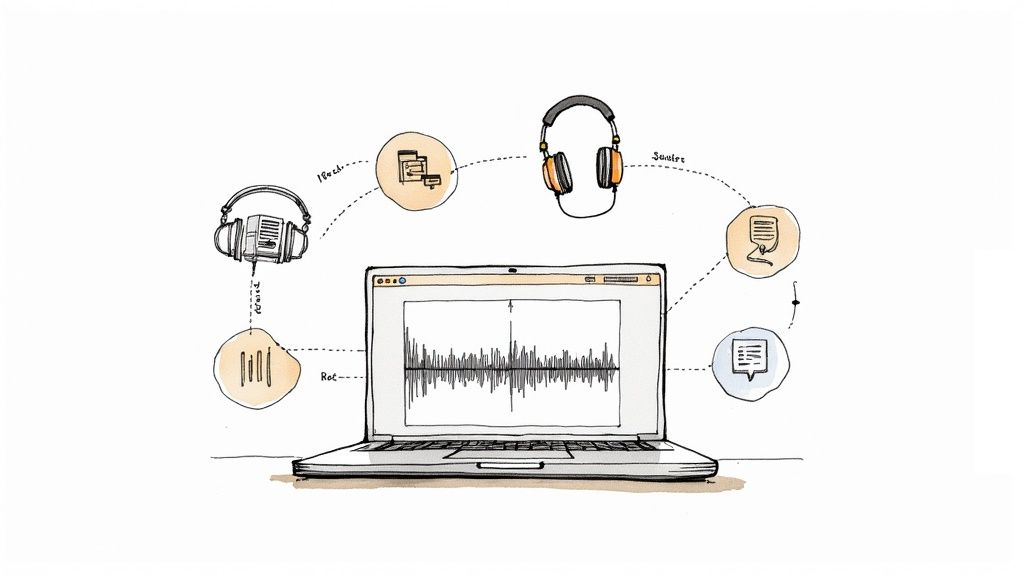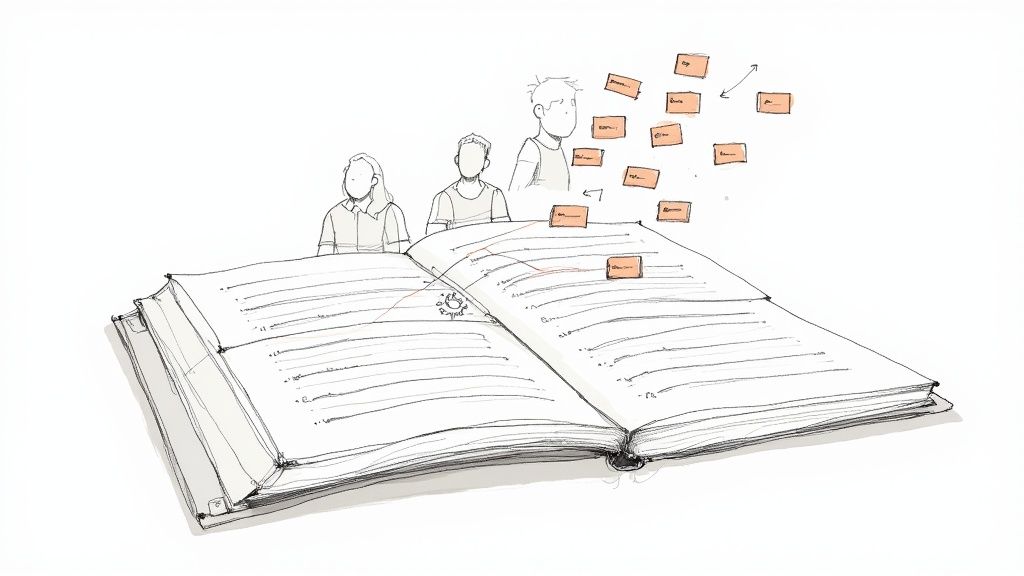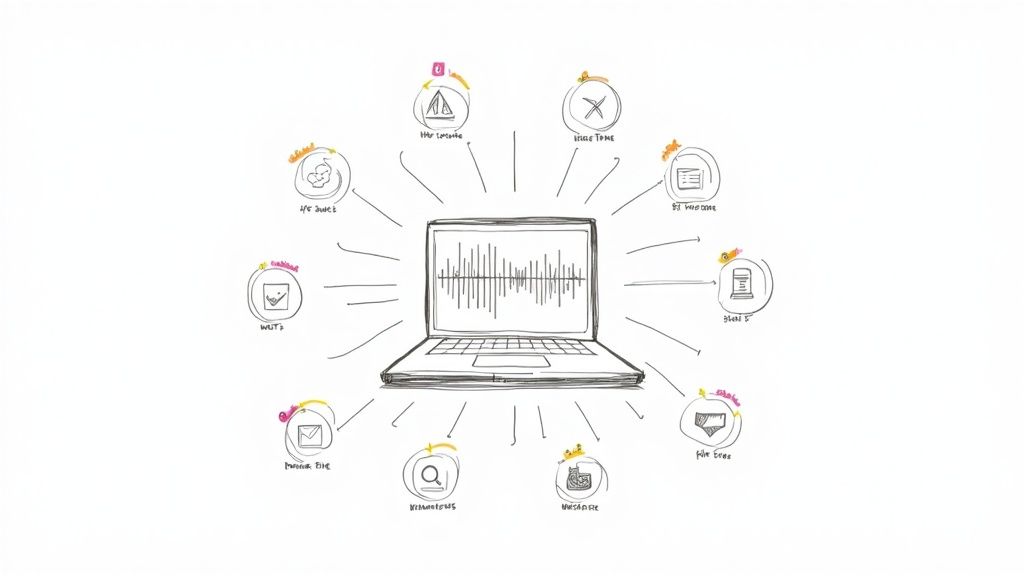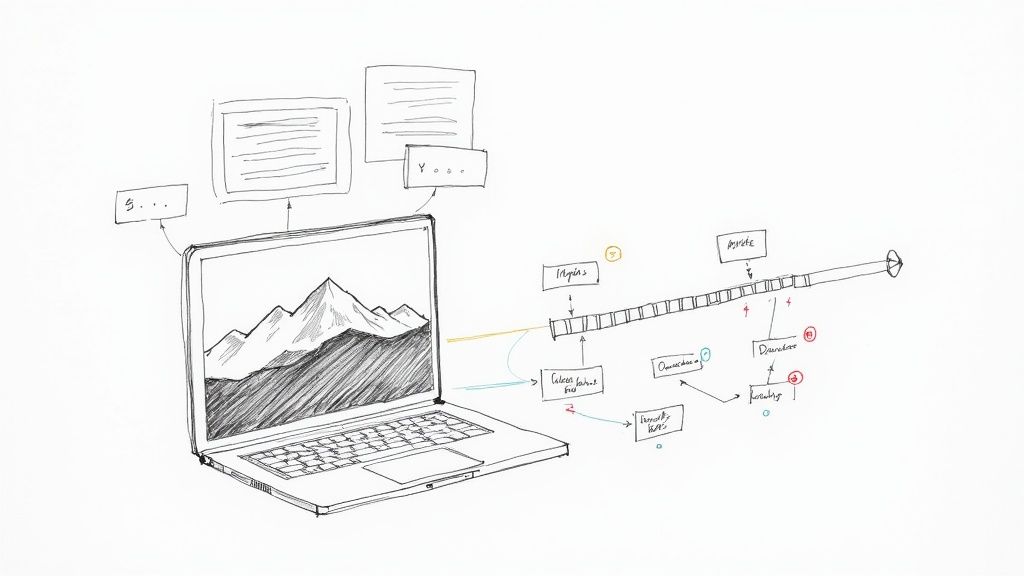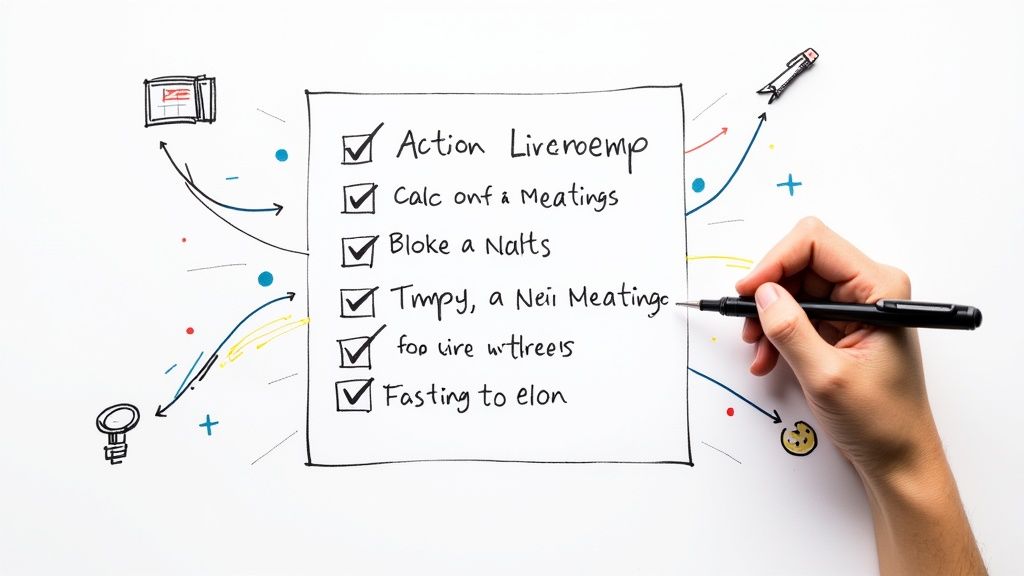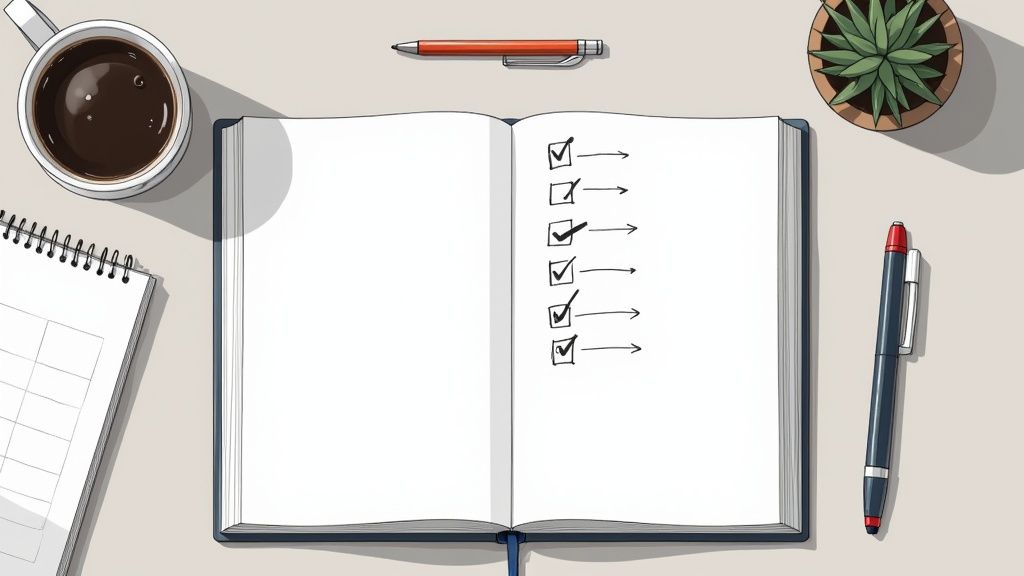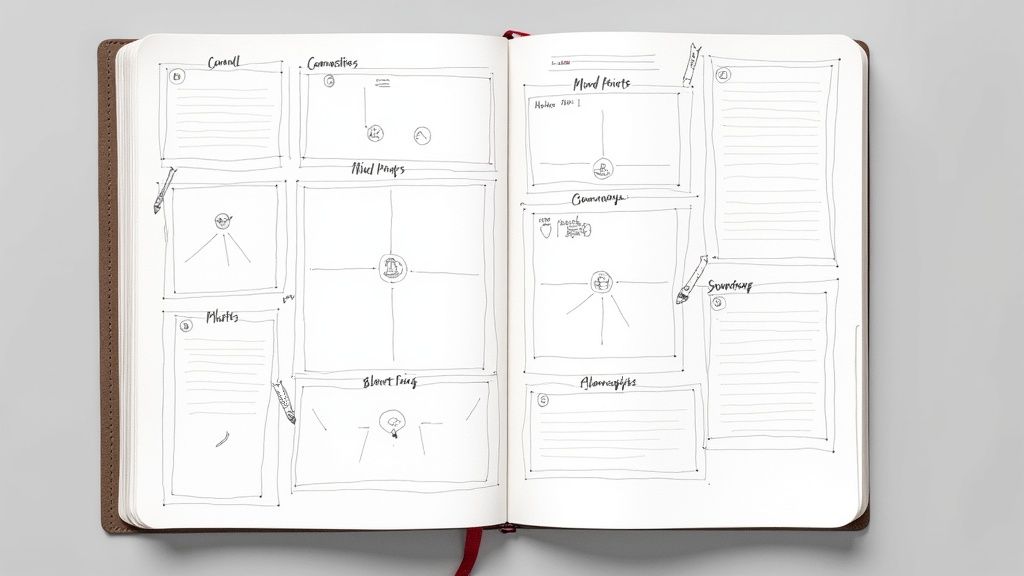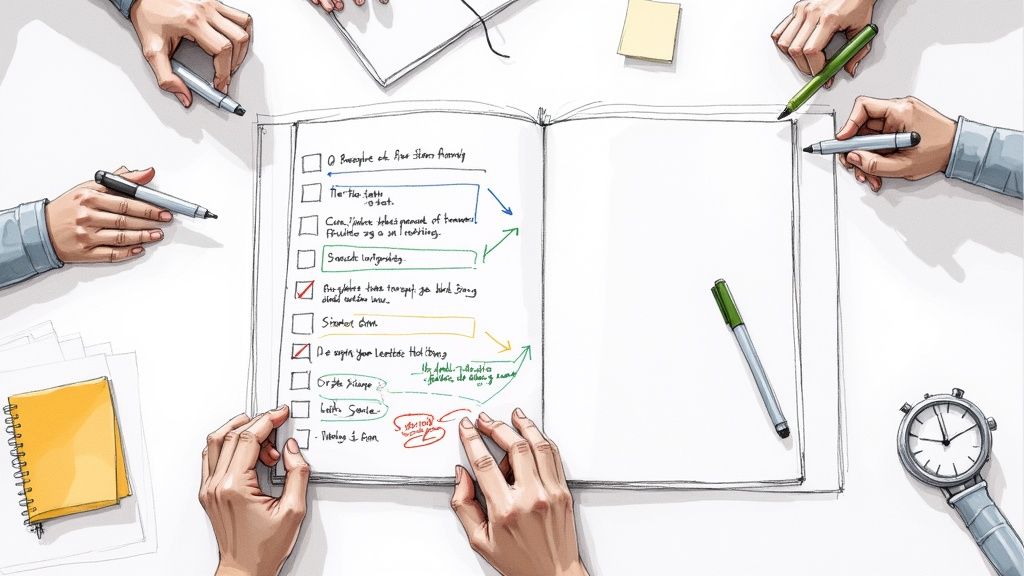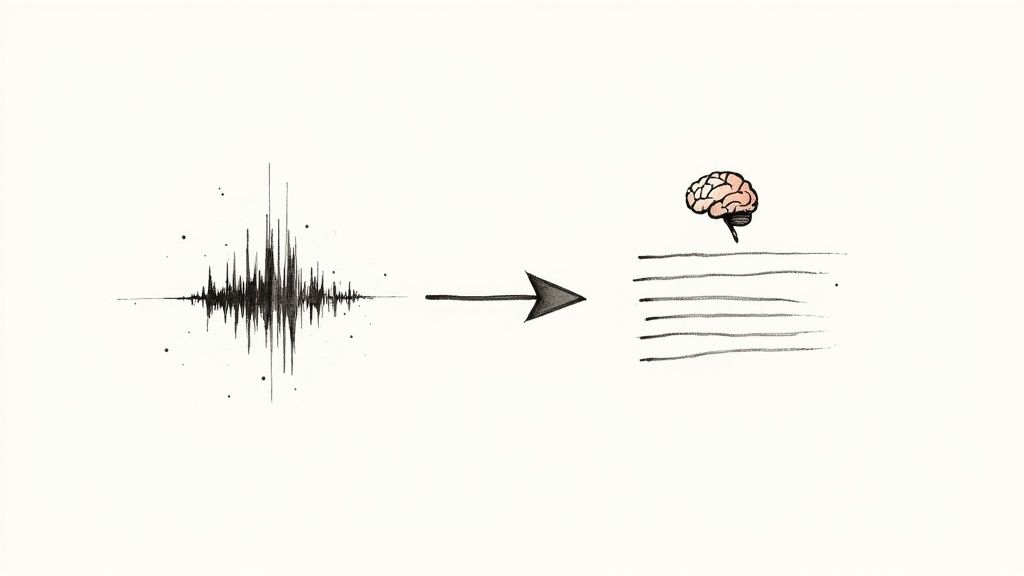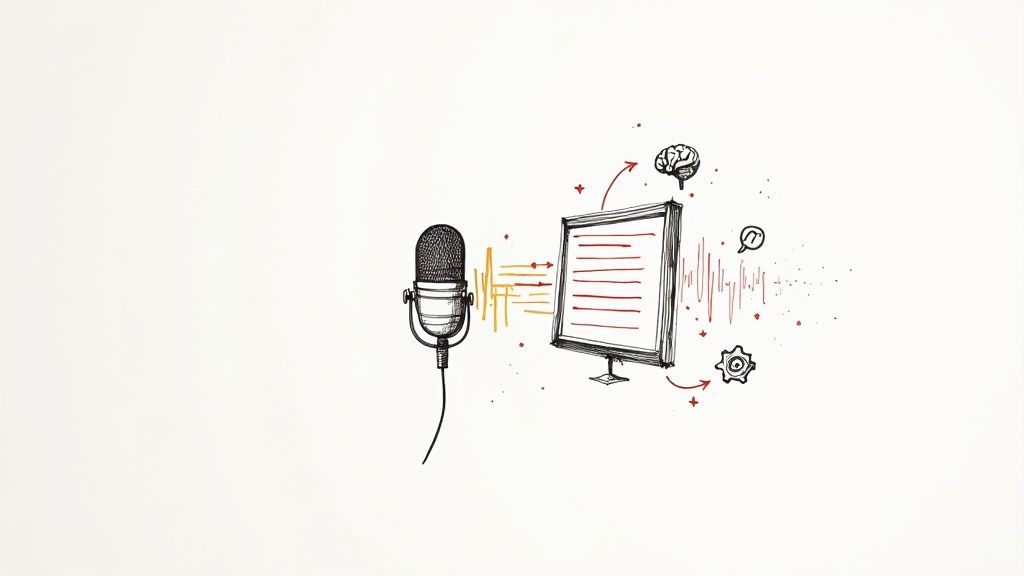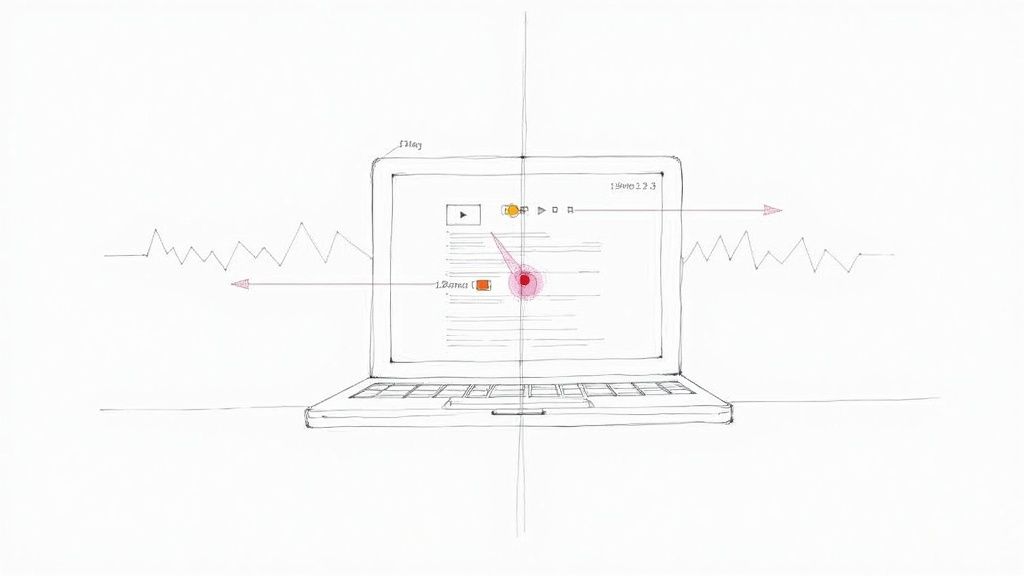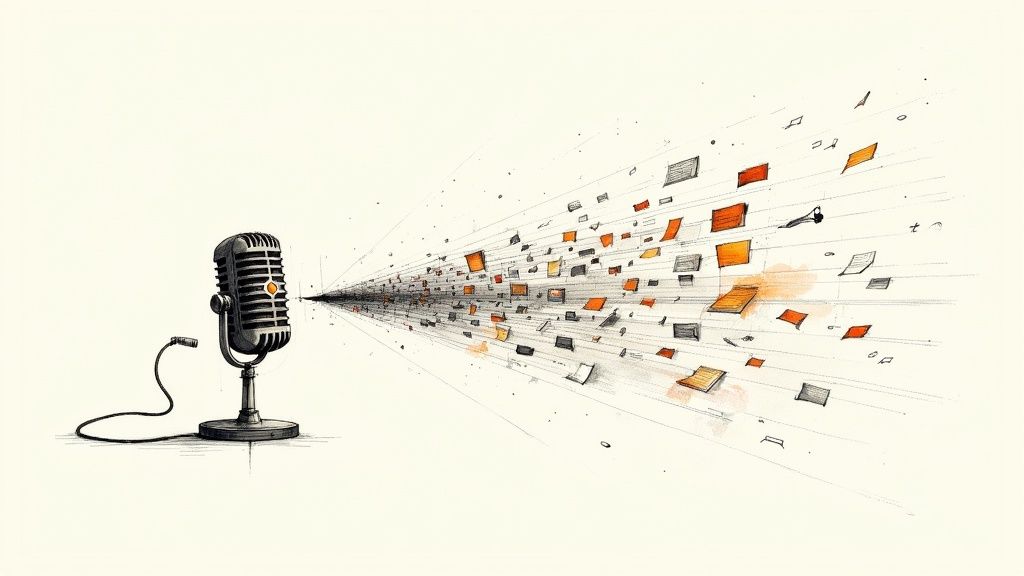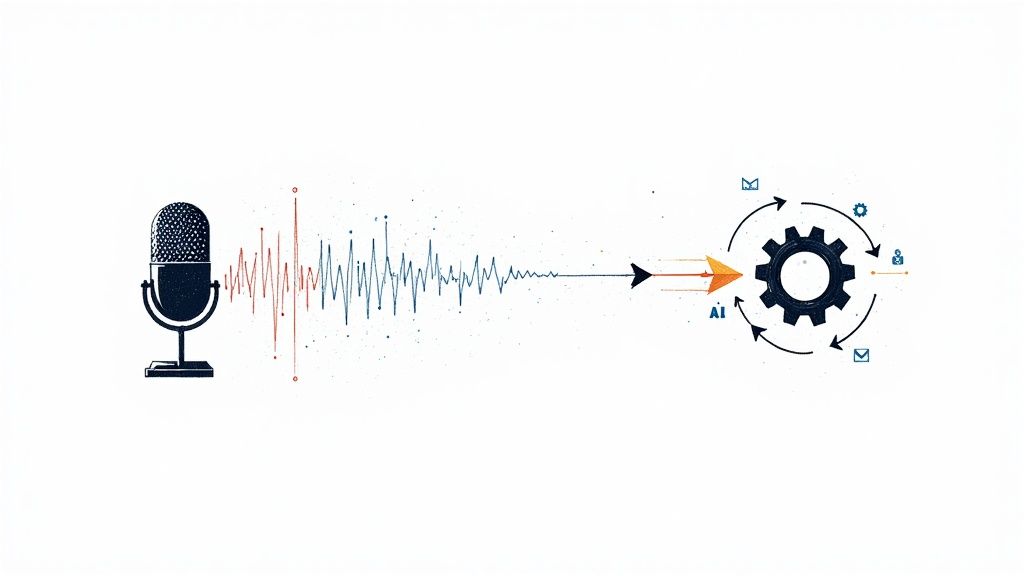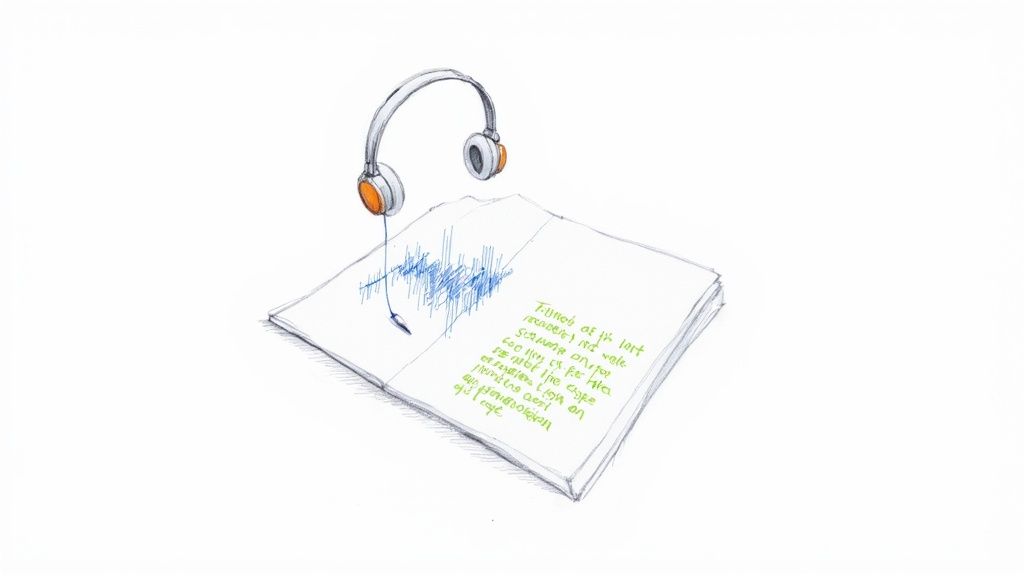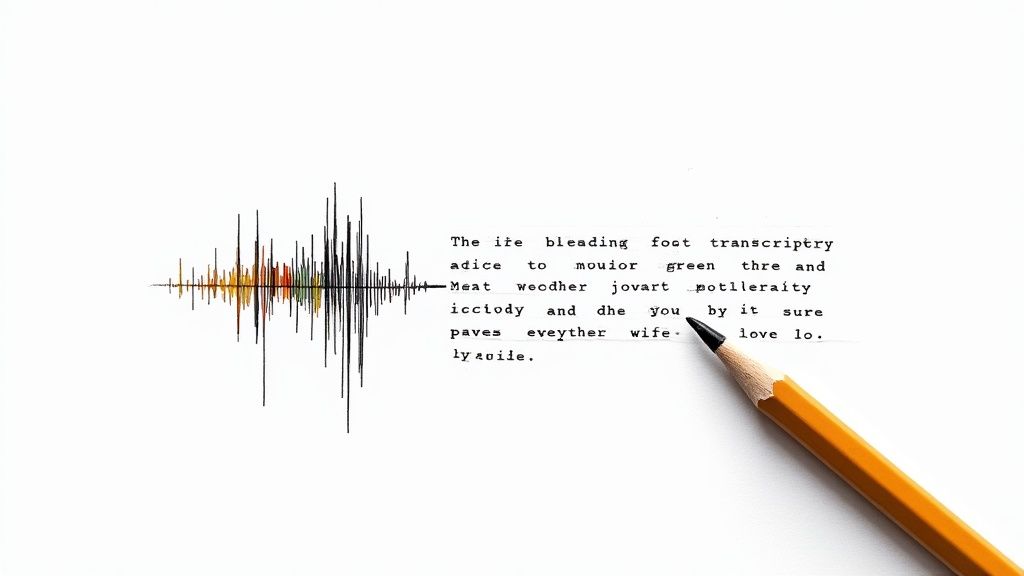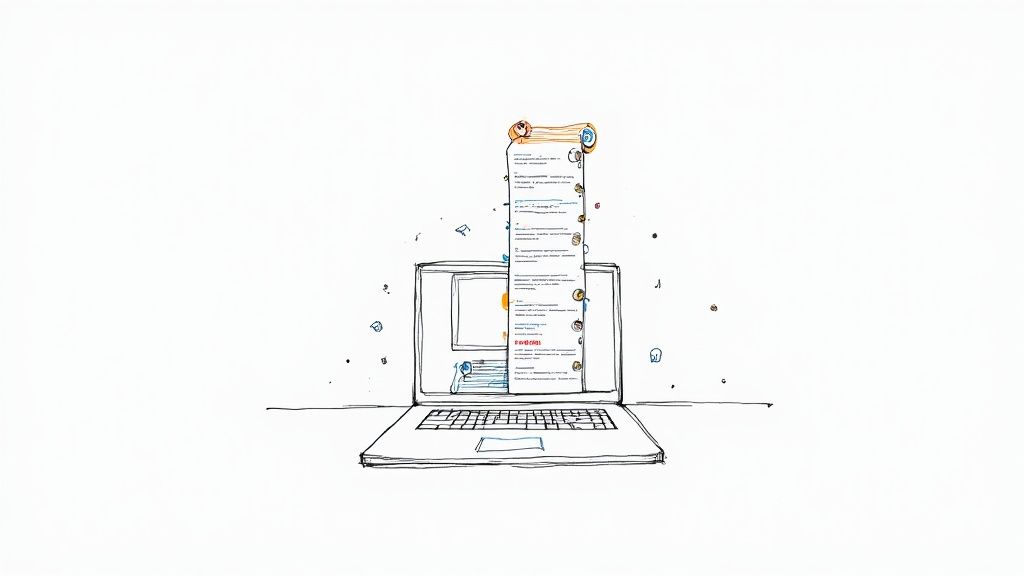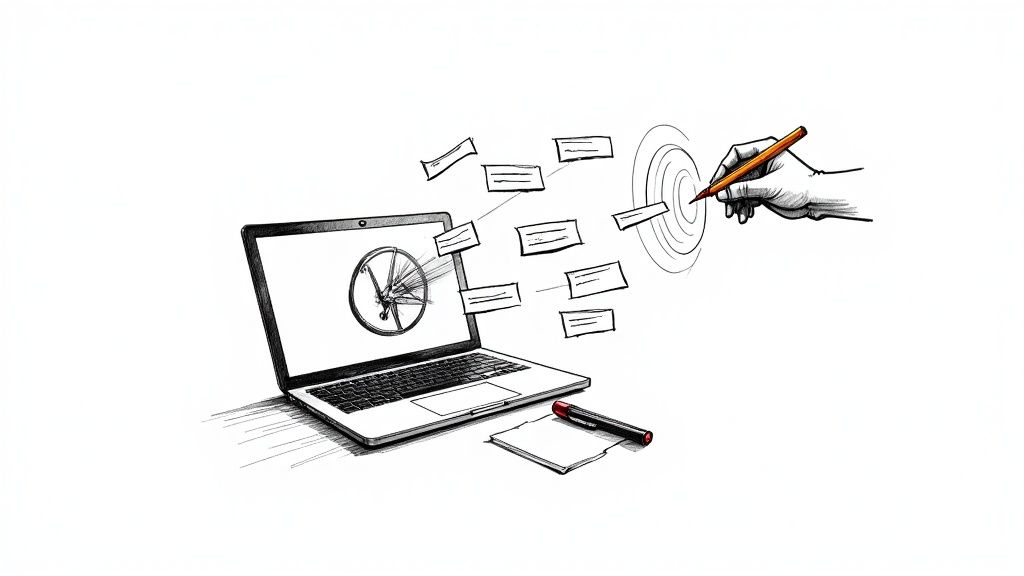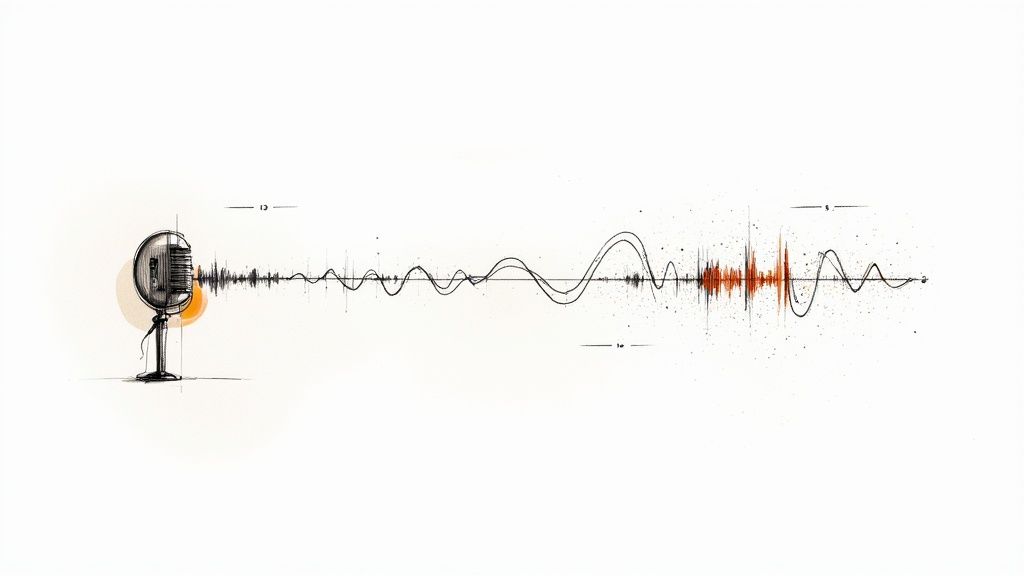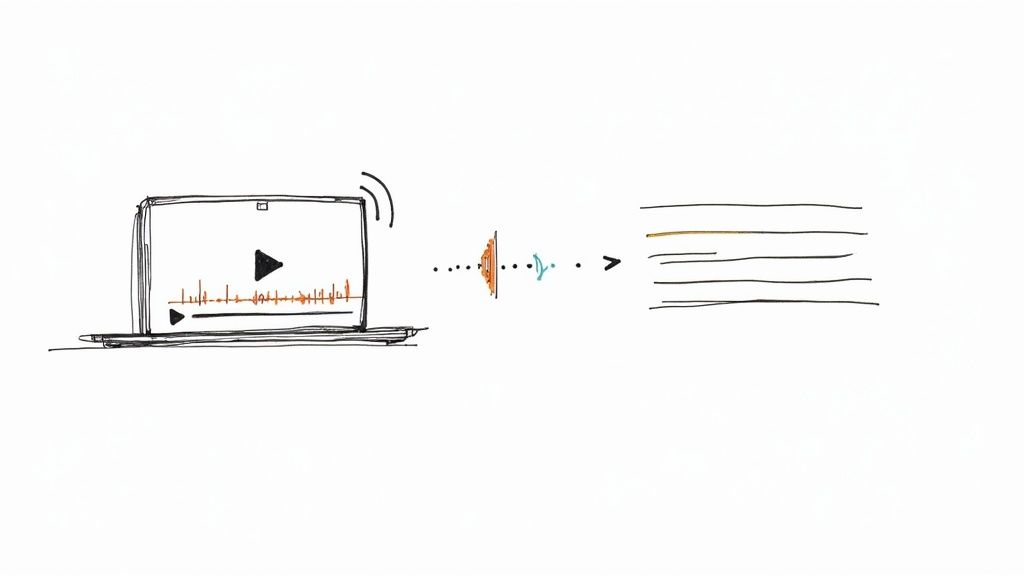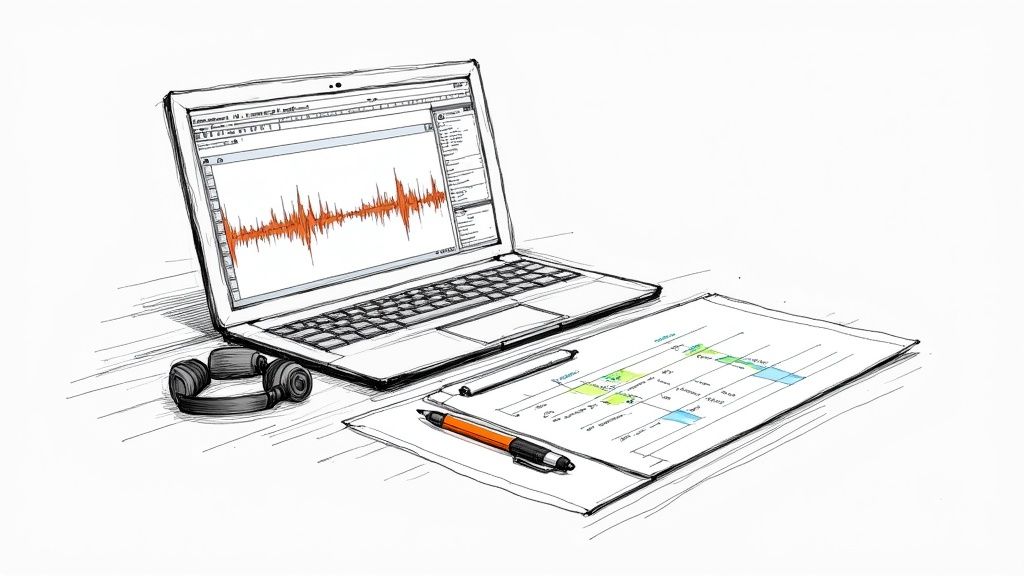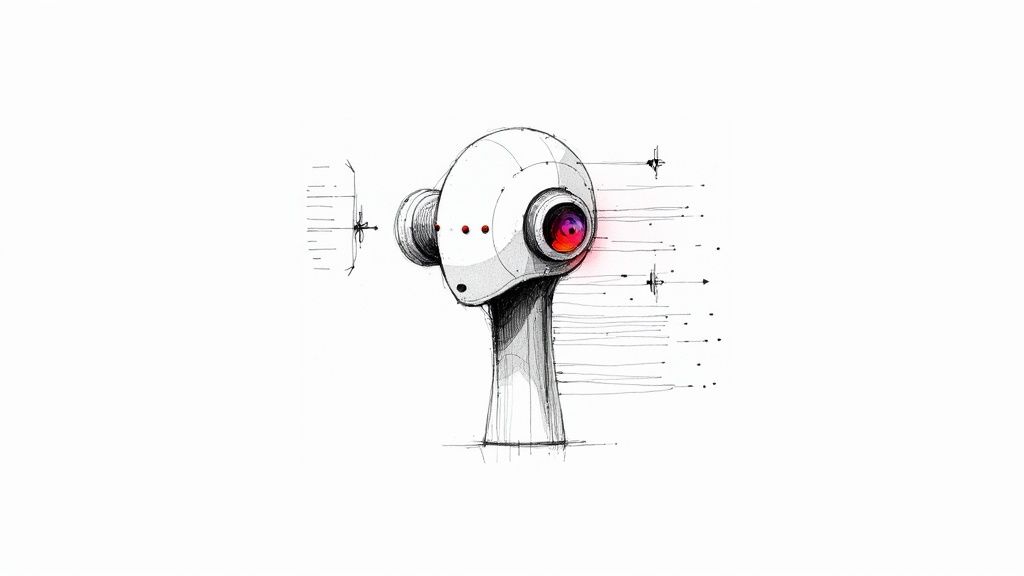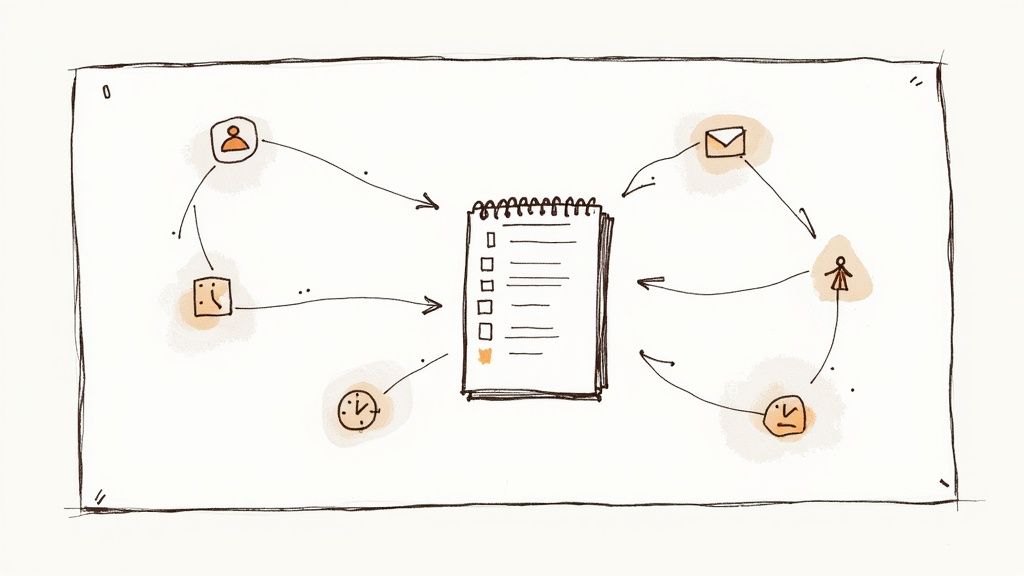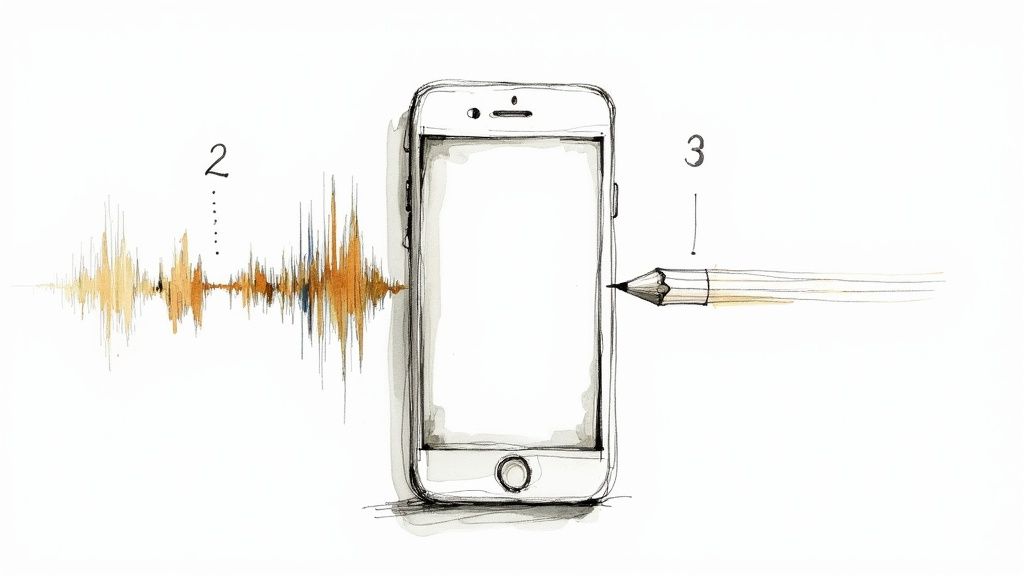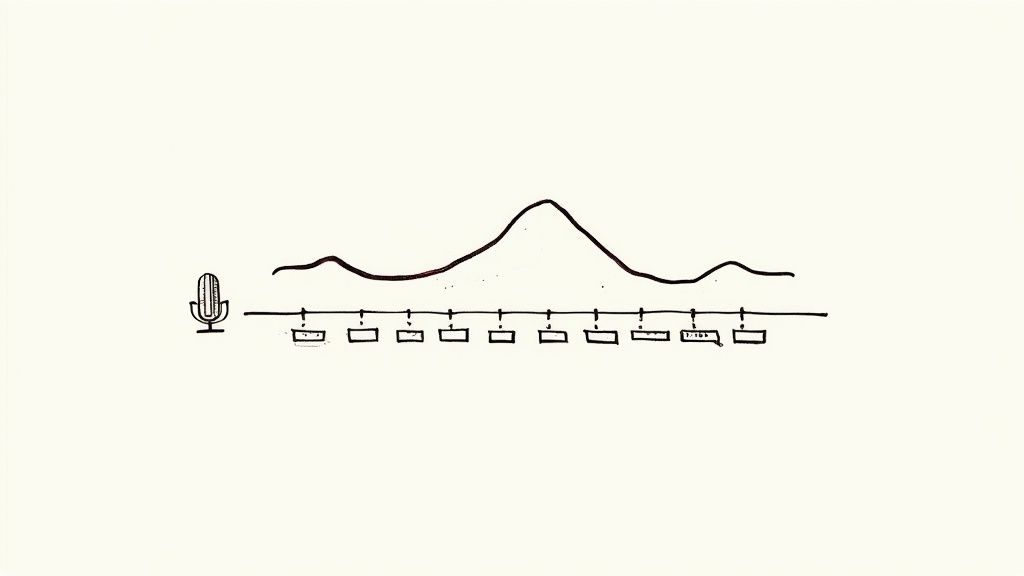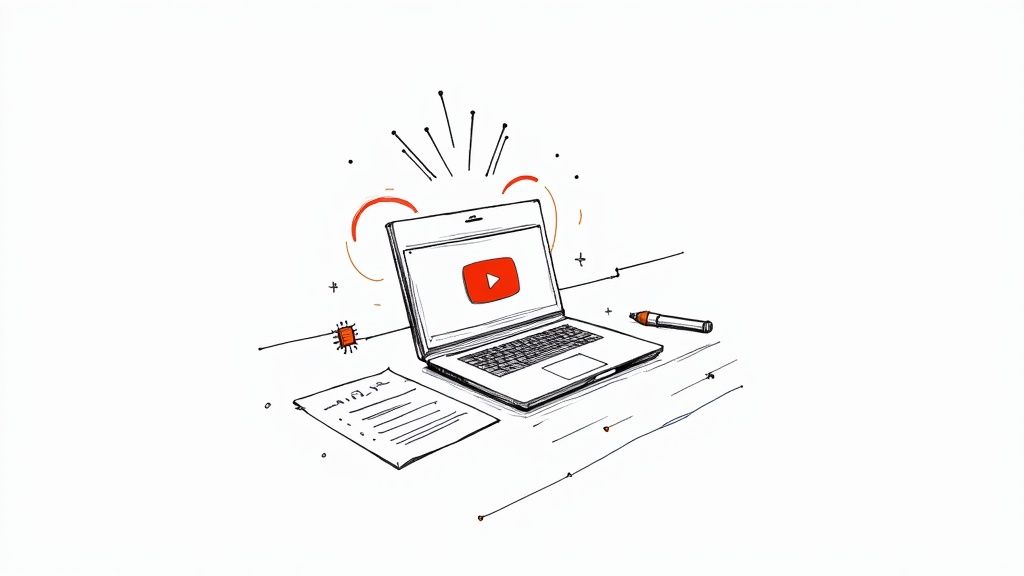
Mastering the Art of Taking Minutes for Meetings
Taking effective meeting minutes is about more than just typing what's said—it’s about being a strategic partner in the meeting's success. Your real work begins long before anyone joins the call. This preparation separates a simple record from a document that drives action.
Laying the Groundwork for Perfect Meeting Minutes

The quality of your minutes is largely decided before the meeting even starts. Walking in unprepared is a recipe for disorganized notes. It's like trying to build a house without a blueprint—you might end up with something, but it won't be functional.
My first step is always to connect with the meeting organizer. I don’t just grab the agenda; I try to understand the why behind each item. This gives me a head start, letting me anticipate the important discussions and the key decisions that need to be made.
For example, if I see an agenda item like "Q4 Budget Review," I'll ask, "What is the primary goal for this topic? Are we looking to finalize the budget, identify areas for cuts, or is this just a status update?" Knowing the objective ahead of time helps me filter out conversational noise and focus on capturing what truly matters for the record.
Your Pre-Meeting Preparation Checklist
Follow these essential steps before each meeting to set yourself up for successful and efficient minute-taking.
This proactive work is a lifesaver. It helps me stay ahead of the conversation instead of just trying to keep up with it.
Aligning on Goals and Objectives
This preparation is especially important in today's fast-paced work environment. With 94% of meetings scheduled for 60 minutes or less, there’s no time to waste. Even more telling, a surprising 64% of recurring meetings don't have a set agenda. When time is tight and structure is loose, your preparation is what brings clarity to the chaos.
My personal rule of thumb? I spend at least 15 minutes preparing for every hour of meeting time. That investment always pays off, allowing me to capture the substance of the discussion instead of just scrambling to type everything.
Choosing Your Minute-Taking Tools
The right tools should make your job easier, not harder. Whether you prefer a sophisticated app or a simple digital document, the key is consistency.
For me, having a pre-built template loaded up in my tool of choice is non-negotiable. It's a simple step, but it saves significant time and ensures I never forget basic details like the date or the list of attendees.
If you want to refine your own process, our complete guide on preparing meeting minutes offers a deeper dive into these strategies. This groundwork turns the task of taking minutes from a reactive chore into a proactive, valuable contribution.
Capturing What Matters During the Meeting
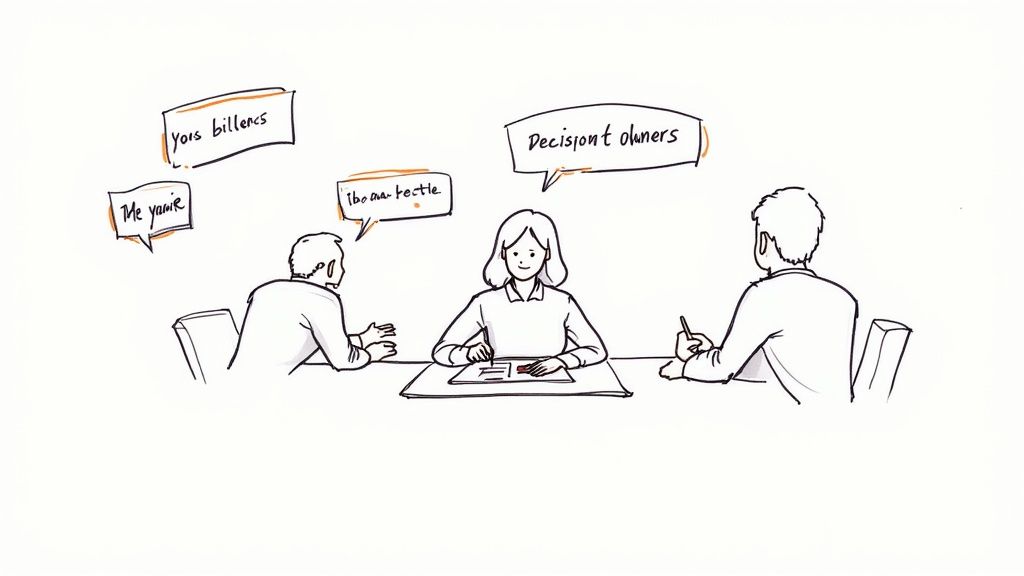
Once the meeting starts, your job is to be a filter, not a sponge. You aren’t trying to create a word-for-word transcript. The real goal is to distill the conversation into a clear, concise record of what was decided and what happens next.
Think of it this way: someone who missed the meeting should be able to read your minutes and know exactly what was decided and what the next steps are. This requires you to listen differently—tuning in for the key decisions and action items while letting the rest of the noise fade away.
The Core Mission: Decisions and Action Items
Your primary focus should be on documenting concrete outcomes. The moment a decision is made, you should be writing it down. But don't just stop at what was decided. Capturing the "why" behind it is just as important. That bit of context can be a lifesaver weeks or months down the road.
For instance, "Decision: New marketing campaign will launch in Q3" is adequate.
But this is much better: "Decision: New marketing campaign launch moved to Q3 to align with product updates and avoid Q2 budget constraints." The second version proactively answers the questions that will inevitably come up later.
At the same time, you need to be vigilant for action items. A task without a name and a deadline next to it is just a wish. It's almost guaranteed to be forgotten by the next meeting.
Over the years, I've developed a simple habit for this. In my notes, I use a consistent tag like [Action Item] – [Owner] – [Due Date]. It makes these tasks stand out when I’m editing the minutes later. This small practice has made a huge difference in team accountability.
Don't Forget the Supporting Details
While decisions and actions are the main event, a few other pieces of information give your minutes the structure they need to be truly useful.
Here's a quick checklist of what else to capture:
- Who Was There (And Who Wasn't): Jot down attendees and anyone who sent their apologies. This is crucial for knowing who was in the room when key decisions were made.
- The Gist of the Discussion: Briefly summarize the main viewpoints or options that were on the table for each agenda item. There's no need to capture every single comment, just the essence of the debate that led to the outcome.
- Formal Motions and Votes: If it's a more formal setting like a board meeting, you must be precise. Record motions exactly as stated, who proposed them, and the final vote count.
Getting these details right transforms your notes from a simple summary into an official, reliable record of the meeting's progress.
Keeping Up with Modern Meetings
The way we meet has changed. Professionals are actually spending less total time in meetings—down from 21.5 hours per week in 2021 to 14.8 hours in 2024. Yet, paradoxically, the number of meetings we have has jumped by 12.9% since before the pandemic. You can find more insights on these meeting trends and what they mean for productivity.
This shift toward shorter, more frequent check-ins makes the practice of taking minutes meetings more critical than ever. It's the only way to keep projects moving forward and ensure everyone stays aligned.
With less time in each meeting, you have to be ruthlessly efficient. By zeroing in on these core components, you create a document that is both concise and powerful, perfectly suited for today’s fast-paced environment. Your role is to make sure that even a quick 45-minute sync leaves a clear and actionable trail.
Turning Raw Notes into Actionable Minutes
Once the meeting wraps up, the real work of minute-taking begins. Your initial notes are just the raw material. The goal now is to shape them into a clear, concise record that drives action, rather than just getting filed away in a folder.
The first thing I always do is take a short break—maybe 15 or 20 minutes—to clear my head. This helps me shift from frantically typing to thinking strategically about the content. When I return to my notes, I can see them with fresh eyes, making it much easier to spot what’s confusing, what’s missing, and how to organize everything logically.
Design for Skimming, Not Deep Reading
Let's be honest: nobody wants to read a novel-length block of text from a meeting. Everyone is busy. Your minutes need to be built for skimming, so a project manager or team lead can find what they need in seconds. Think of it less like a transcript and more like a high-level summary.
Formatting is your secret weapon here. A few simple tricks can make the crucial information stand out:
- Bold the big stuff: Every decision and action item should be in bold. It’s the fastest way to guide the reader’s eye to the most critical takeaways.
- Use smart headings: Structure the minutes to mirror the agenda. This creates a natural flow and lets people jump straight to the topics that matter to them.
- Embrace bullet points: When a discussion gets complex or a list of tasks is generated, break it down into simple, digestible bullet points.
Focusing on scannability makes it far more likely that your colleagues will actually read and use the minutes. If you're looking for a great starting point, this meeting action items template is a fantastic example of how to structure your document effectively.
Getting Approval and Sending It Out
With the minutes polished and ready, it's time to get them into people's hands. A common mistake is to send the draft to every attendee for feedback. This almost always leads to a chaotic mess of conflicting suggestions and delays.
My rule of thumb is to keep the approval circle small. Only the meeting organizer or the chair really needs to give the final sign-off. I send the draft to them directly for a quick accuracy check. This "two-person rule" avoids a "too many cooks in the kitchen" situation and keeps the process moving.
Once you have the green light, send the final version out promptly. I always aim to distribute the minutes within 24 hours of the meeting. This keeps the conversations and commitments fresh in everyone's minds and helps maintain momentum.
Finally, don't just email it as an attachment that will get lost. Store the document in a central, shared location—like a team SharePoint, Google Drive folder, or your project management software—and email a direct link to the team. This simple, reliable workflow ensures your hard work leads to real progress.
Using AI Tools to Take Smarter Meeting Minutes
Let's be honest, trying to manually type every word in a meeting is a losing battle. Your focus splits between listening and typing, and you inevitably miss key nuances. This is where technology becomes your best ally, letting you step back from being a stenographer and participate in the actual conversation.
The game-changer here is letting an AI handle the transcription. I’ve found that using a tool like Whisper AI to create a word-for-word record of the meeting is invaluable. It’s like a safety net; you know every detail is captured, which frees you up to actively listen and understand the dynamics in the room.
Once the meeting ends, the real work begins. Here’s a simple workflow that I follow to get from raw recording to final, distributed minutes.

This straightforward process of editing, getting a quick approval, and then sending the notes out keeps the whole team aligned and ensures accuracy.
From Raw Transcript to Polished Minutes
A raw transcript is just the starting point—it's not the finished product. Your real value as a minute-taker comes from transforming that wall of text into a concise, actionable summary. This is where AI summarization tools can save you a massive amount of time.
After the meeting, I feed the transcript into an AI model and give it specific instructions. It's much more than just asking for a generic summary.
- Pinpoint Key Decisions: I'll prompt it to pull out every sentence where a final decision was made.
- Extract Action Items: A great prompt is: "List all tasks, who they are assigned to, and any mentioned deadlines."
- Summarize Discussion Points: You can even have it condense the main arguments for and against a specific topic.
From my experience, the magic happens when you refine what the AI gives you. I always take the first draft from the AI and then edit it myself for tone, clarity, and any missing context. This "human-in-the-loop" approach gives you the speed of automation with the critical thinking that only a person can provide.
This hybrid workflow has seriously cut down the time I spend on post-meeting administrative tasks.
Digging Deeper with AI Insights
Today’s AI tools can do a lot more than just transcribe and summarize. For those who are curious, understanding the underlying principles of AI question answering can give you a real edge in crafting effective prompts. With a bit of knowledge, you can ask the AI to identify recurring themes, detect the sentiment during a heated debate, or even draft a follow-up email based on the meeting’s outcomes.
The explosion of remote work has only made these tools more relevant. Between 2020 and 2022, the percentage of virtual meetings skyrocketed from 48% to 77% worldwide. This digital-first environment makes recording and transcribing meetings almost effortless.
Despite this, a recent survey found that only 14% of meeting planners see AI as a critical technology right now. That signals a huge opportunity for those of us willing to adopt it early.
Ultimately, bringing AI into your minute-taking process is about working smarter, not harder. You can explore a variety of AI-powered transcription services to see which one feels right for your team. By automating the heavy lifting, you get to focus on the truly strategic work: ensuring the minutes are clear, accurate, and actually drive action.
Helpful Templates and Phrasing Examples for Taking Minutes
Trying to capture a fast-moving conversation from scratch is tough. That’s why having a good template and some go-to phrasing in your back pocket can be a lifesaver. It takes the guesswork out of the process, helping you record information professionally and consistently, every single time.
A solid template provides the skeleton, while a list of common phrases ensures your language stays clear, objective, and on point. I've spent years refining my own template, and it’s become my secret weapon for everything from formal board meetings to quick team huddles.
A Go-To Meeting Minutes Template
The beauty of this framework is its simplicity. It’s structured to make sure you never miss a critical detail, and I always have it loaded up in a document before a meeting begins.
- Meeting Title: [Project Name] - [Meeting Topic]
- Date & Time: [Date], [Start Time] - [End Time]
- Location: [Physical or Virtual Link]
- Attendees: [List everyone present]
- Apologies: [List anyone who couldn't make it]
- Topic 1: [Summarize the key points, questions, and insights]
- Topic 2: [Summarize the key points, questions, and insights]
- [Decision 1, including the rationale behind it]
- [Decision 2, including the rationale behind it]
- [Action Item 1]: Assigned to [Owner], Due: [Date]
- [Action Item 2]: Assigned to [Owner], Due: [Date]
This layout makes the final document incredibly easy to scan and digest, which is exactly what your team needs.
A great template doesn't just organize information—it guides your listening during the meeting. When you know exactly where each piece of information needs to go, you become much more efficient at filtering the conversation for what truly matters.
Professional Phrasing for Common Meeting Scenarios
Beyond the structure, the words you choose matter. Having a mental list of professional, objective phrases makes documenting tricky or sensitive situations much easier. This helps you stick to the facts and avoid injecting subjective or emotional language.
Here's a quick reference guide with some professional phrasing I rely on to capture different meeting outcomes accurately.
Go-To Phrasing for Common Meeting Scenarios
These examples help maintain a neutral, professional tone that keeps the focus on outcomes, not personalities. They’re a simple but powerful tool for anyone tasked with creating the official record of a meeting.
Common Questions About Taking Meeting Minutes
Even the most seasoned minute-takers run into tricky situations. Let's walk through some of the questions I hear most often and give you some practical, field-tested advice to handle them like a pro.
How Much Detail Should I Include in Meeting Minutes?
This is the most common question. The goal is clarity, not a novel. You're creating a summary of outcomes, not a word-for-word transcript. The purpose of minutes is to document the critical decisions, the logic behind them, and what needs to happen next.
Here’s a simple test: could a colleague who missed the meeting read your notes and understand exactly what was decided and who is responsible for what? For a standard one-hour meeting, a single, well-organized page is usually perfect. Go much longer, and you risk nobody reading it at all.
How Do I Handle Arguments or Tense Moments?
Your job is to remain neutral and objective. You're there to record the outcome, not the emotional fireworks. It's vital to capture the substance of the discussion without injecting your own opinion or using loaded language.
So, instead of writing, "Jane got really heated and shot down Tom's idea," try this: "A concern was raised about the budget's impact on Q4 timelines. An alternative approach was proposed focusing on resource reallocation. After discussion, the team agreed to move forward with the original proposal." This captures the differing views and the final decision, minus the drama.
The best minutes stick to the facts. By impartially summarizing the core arguments and the final decision, you create a professional record that’s useful for everyone, no matter where they stood in the debate.
Should I Record the Meeting to Help with Taking Minutes?
Recording a meeting—with everyone's permission, of course—can be a fantastic safety net. It's not a replacement for taking notes live, but it's an excellent backup. The biggest advantage is accuracy; you can always go back to confirm a specific detail or quote.
The major downside, however, is the time commitment. Listening to an entire hour-long meeting again just to find one detail is inefficient. My advice? Go with a hybrid approach:
- Take your main notes in real-time, focusing on decisions, action items, and owners.
- Use the recording only to double-check specific points or get the exact phrasing right later on.
This gives you the accuracy of a recording without the tedious task of a full re-watch.
How Soon After the Meeting Should I Send the Minutes?
Get them out the door within 24 hours. When the conversation is still fresh in everyone's minds, it’s much easier to get quick feedback or corrections if you missed something.
Sending them out quickly also means people can get started on their action items right away. It keeps the momentum going and proves the meeting was productive. If you wait, you're practically inviting people to forget their commitments.
Stop wrestling with manual notes. Whisper AI can give you perfect meeting summaries, instantly. It transcribes and summarizes your meetings, pulling out key decisions and action items so you can stay focused on the conversation. Check out Whisper AI and see how it can completely change your meeting workflow.

